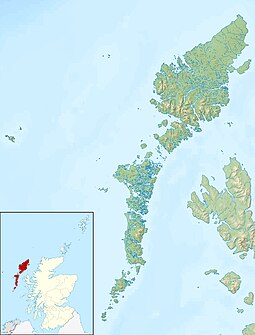Vallay (Scottish Gaelic: Bhàlaigh) is an uninhabited tidal island in the Scottish Outer Hebrides. It can be reached from North Uist by a long beach at low tide.
| Scottish Gaelic name | Bhàlaigh |
|---|---|
| Meaning of name | hill island |
| Location | |
| OS grid reference | NF769763 |
| Coordinates | 57°39′38″N 7°25′09″W / 57.660690°N 7.419152°W |
| Physical geography | |
| Island group | Outer Hebrides |
| Area | 260 hectares (1.00 sq mi) |
| Area rank | 94 [1] |
| Highest elevation | 38 metres (125 ft) |
| Administration | |
| Council area | Comhairle nan Eilean Siar |
| Country | Scotland |
| Sovereign state | United Kingdom |
| Demographics | |
| Population | 0[2] |
| References | [3][4] |


Once the island supported a population of nearly sixty people. Its best-known inhabitant was the archaeologist Erskine Beveridge. The island is also known for its sea birds and for prehistoric monuments.
References
edit- ^ Area and population ranks: there are c. 300 islands over 20 ha in extent and 93 permanently inhabited islands were listed in the 2011 census.
- ^ National Records of Scotland (15 August 2013). "Appendix 2: Population and households on Scotland's Inhabited Islands" (PDF). Statistical Bulletin: 2011 Census: First Results on Population and Household Estimates for Scotland Release 1C (Part Two) (PDF) (Report). SG/2013/126. Retrieved 14 August 2020.
- ^ Ordnance Survey. OS Maps Online (Map). 1:25,000. Leisure.
- ^ Haswell-Smith, Hamish (2004) The Scottish Islands. Edinburgh. Canongate.
- ^ "Vallay House, Vallay | Buildings at Risk Register". www.buildingsatrisk.org.uk. Retrieved 3 August 2021.
Wikimedia Commons has media related to Vallay.
57°39′42″N 7°24′24″W / 57.66167°N 7.40671°W
